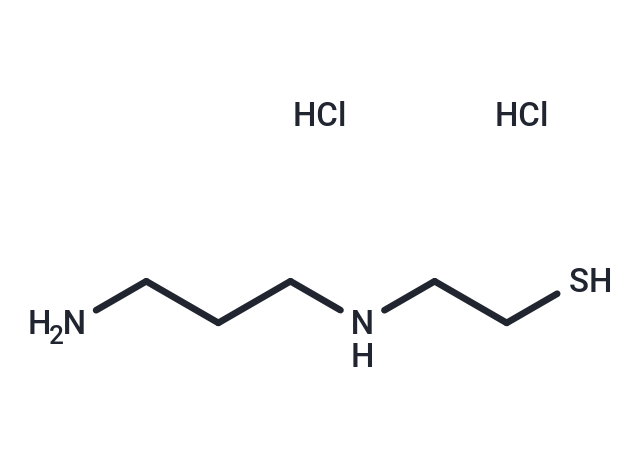Shopping Cart
Remove All Your shopping cart is currently empty
Your shopping cart is currently empty
Amifostine thiol dihydrochloride (WR 1065) can activate p53 through a JNK-dependent signaling pathway. It also protects normal tissues from the toxic effects of certain cancer drugs.

| Pack Size | Price | USA Warehouse | Global Warehouse | Quantity |
|---|---|---|---|---|
| 5 mg | $30 | In Stock | In Stock | |
| 10 mg | $44 | In Stock | In Stock | |
| 25 mg | $74 | In Stock | In Stock | |
| 50 mg | Preferential | In Stock | In Stock | |
| 1 mL x 10 mM (in DMSO) | $38 | In Stock | In Stock |
| Description | Amifostine thiol dihydrochloride (WR 1065) can activate p53 through a JNK-dependent signaling pathway. It also protects normal tissues from the toxic effects of certain cancer drugs. |
| In vitro | The DNA-binding activity is increased in a WR-1065 concentration-dependent manner. Cells treated with 1 mM WR-1065 dihydrochloride for 24 h revealed that all of the p53-induced genes analyzed are transactivated following WR-1065 dihydrochloride treatment, in a p53-dependent manner. Significantly, treatment with WR-1065 dihydrochloride leads to a 3-fold increase in luciferase expression driven by AP-1 and a 5-fold increase when this reporter gene is driven by NF-κB when these values are normalized to the level of the cotransfected β-galactosidase gene [2]. |
| In vivo | WR-1065 attenuates the severity of 6-OHDA-induced catalepsy when compared with 6-OHDA-lesioned rats. Also, it has been observed that WR-1065 dihydrochloride improves catalepsy in a dose-dependent manner. Pretreatment with three different doses of WR-1065 dihydrochloride (20, 40, and 80 μg/2 μL/rat) for 3 days before 6-OHDA administration, significantly elevates SOD activity and restores it to normal range compare with 6-OHDA lesioned rats [3]. |
| Cell Research | For Western analysis, cells are treated with 1 mM WR-1065 for 24 h, and subconfluent cultures of cells are harvested and lysed in RIPA buffer supplemented with protease inhibitors. Protein concentrations are determined by a detergent-compatible assay. Western blots are blocked and incubated in antibody in PBS/0.2% Tween 20/5% nonfat dry milk. Blots are incubated with 1 μg/mL antibody for 1 h at room temperature, followed by washing in PBS/0.2% Tween 20 and incubation in peroxidase-conjugated secondary antibody and chemiluminescence detection [2]. |
| Animal Research | Seventy-two rats are divided randomly into 9 equal groups: 1) Control group receives no injection and is left untreated for the entire period of the experiment as intact animals; 2) Sham-operated group is subjected only to surgical procedure; 3) Vehicle (saline)-treated group receives 2 μL saline (Intra-SNc); 4) Lesioned group receives 6-hydroxydopamine; 5) Vehicle+6OHDA group receives saline as a vehicle 3 days once daily (2 μL/rat) before 6-OHDA injection; 6 to 8) Rats in these groups are pretreated with Intra-SNc injection of WR-1065 (20, 40 and 80 μg/2 μL/rat) 3 days before 6-OHDA injection; 9) Non-lesioned animals receive intra-SNc injection of WR-1065 dihydrochloride (80 μg/2 μL/rat) for three days [3]. |
| Synonyms | WR 1065 |
| Molecular Weight | 207.165 |
| Formula | C5H16Cl2N2S |
| Cas No. | 14653-77-1 |
| Smiles | Cl.Cl.NCCCNCCS |
| Relative Density. | 0.975g/cm3 |
| Storage | Powder: -20°C for 3 years | In solvent: -80°C for 1 year | Shipping with blue ice/Shipping at ambient temperature. | |||||||||||||||||||||||||||||||||||
| Solubility Information | DMSO: 24 mg/mL (115.85 mM), Sonication is recommended. H2O: 100 mg/mL (482.71 mM), Sonication is recommended. | |||||||||||||||||||||||||||||||||||
| In Vivo Formulation | 10% DMSO+40% PEG300+5% Tween 80+45% Saline: 1 mg/mL (4.83 mM), Sonication is recommended. Please add the solvents sequentially, clarifying the solution as much as possible before adding the next one. Dissolve by heating and/or sonication if necessary. Working solution is recommended to be prepared and used immediately. The formulation provided above is for reference purposes only. In vivo formulations may vary and should be modified based on specific experimental conditions. | |||||||||||||||||||||||||||||||||||
Solution Preparation Table | ||||||||||||||||||||||||||||||||||||
DMSO/H2O
| ||||||||||||||||||||||||||||||||||||
| Size | Quantity | Unit Price | Amount | Operation |
|---|

Copyright © 2015-2025 TargetMol Chemicals Inc. All Rights Reserved.